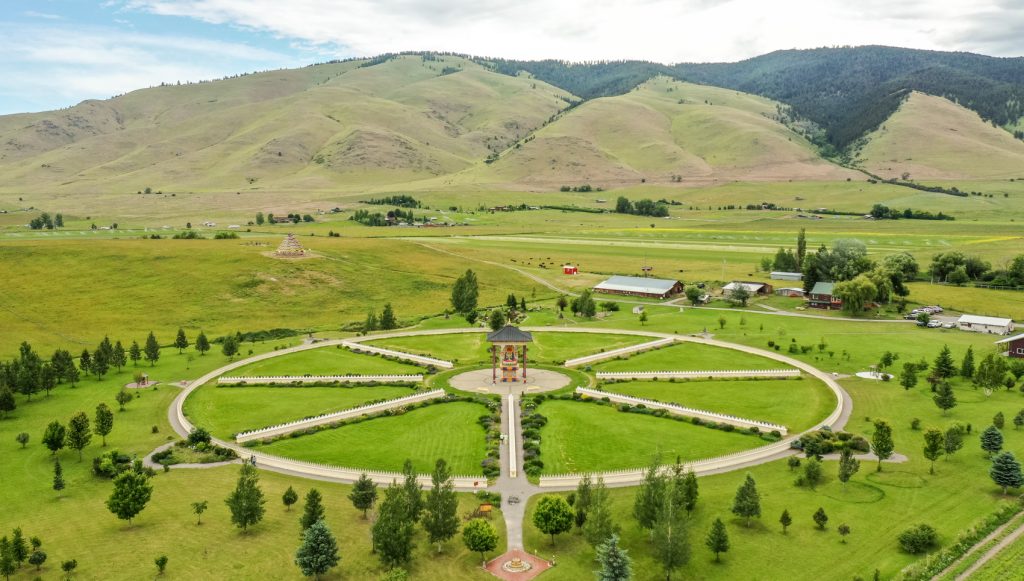Gochen Tulku Sang-ngag Tenzin Rinpoche and Stephen Small Salmon need an interpreter to understand each other’s language, but not the meaning behind their words. Small Salmon’s wife, Juanita, could see it from their first meeting, when Rinpoche shared a story of his exile from Tibet in 1981. Following a nine-year imprisonment by Chinese authorities who invaded his country, the Tibetan Buddhist leader found himself lost in the Himalayas. Then wolves appeared. The pack helped guide him to safety in Bhutan when his trail was obscured by snow.
“That’s the kind of story that Stephen completely and totally understood. … That’s the relationship between humans and animals,” Juanita Small Salmon says. “We’re all related. There’s no separation.”
Rinpoche would later find refuge in Stephen Small Salmon’s homeland in western Montana, and, from that place on the Flathead Reservation, plant a peace garden. The Garden of One Thousand Buddhas, seeded two decades ago, continues to flourish under the care of a Tibetan diaspora within the domain of the Confederated Salish and Kootenai Tribes. The garden is tucked into Rocky Mountains reminiscent of the snowcapped Himalayas of Rinpoche’s youth.
Small Salmon—a spiritual leader for Indigenous people in that region as Rinpoche is for his Buddhist practitioners—blessed the land the garden rests upon. A shared vision for a world that respects all life helps the garden continue to grow.
“There’s a lot of similarities between the respect for the land and balance and the spirit,” says Tom McDonald, chairman of the Confederated Salish and Kootenai Tribes. “There’s a lot of correlations there. There’s a lot of overlap.”
* * *
The Garden of One Thousand Buddhas rests within the tranquil Jocko Valley, a small basin between several ranges of the Rockies north of Missoula and south of Glacier National Park. Its circle of monuments and plants adorns a rural site in Arlee between green farm fields. To the northeast, the fields give rise to the Jocko Hills, and beyond, the majestic Mission Mountains and expansive Flathead Lake.

On a trip to Montana to teach the dharma, Rinpoche recognized this scenic spot from a vision he had as a child of a peace garden in a mountainous valley, and knew this was the place he should create it.
In Tibet, Rinpoche was recognized as a Buddhist leader in early childhood. He is considered the reincarnation of the Gochen Tulku, who tradition holds as the incarnation of Gyelwa Chokyang, one of twenty-five heart disciples of Guru Rinpoche. Following many years of training—including while imprisoned by the Chinese with other Tibetan lamas—he went on to found Ewam International in 1999. Its centers and monasteries in Asia and the United States, including the Garden of One Thousand Buddhas, promote the nonprofit’s mission to advance and cultivate spiritual awareness throughout the world in the tradition of the Nyingma School of Tibetan Buddhism. Rinpoche also occasionally collaborates with affiliated organizations, including a Buddhist retreat center that’s also situated on the Flathead Reservation.
Rinpoche, now 69, started making plans to create the Garden of One Thousand Buddhas in 2000, after one of his students offered him a sixty-acre parcel in the Jocko Valley. The terrorist attacks of 9/11 the following year further informed his vision. With the intent to pacify evils and help restore peace and happiness, Rinpoche created a garden rich with symbolism about enlightenment connected to the Heart Sutra. Destroyed weapons and symbols of war are buried beneath some of the statues, representing a triumph of compassion over negativity.
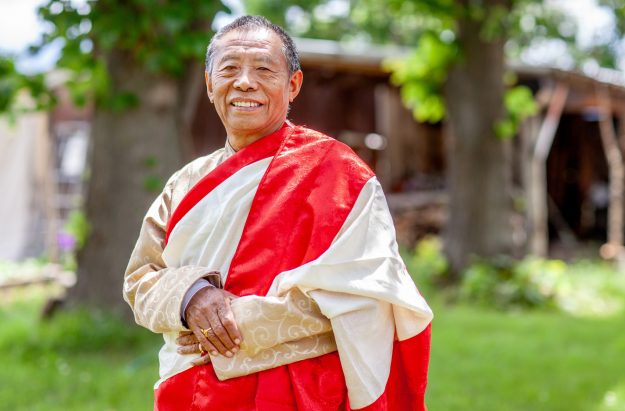
The Dalai Lama, the spiritual leader of Tibetan Buddhism, planned to inaugurate the garden until the 88-year-old’s traveling schedule became more limited in recent years. After Rinpoche had a private audience with the Dalai Lama in India last year, it was decided that another high-ranking Tibetan lama would instead visit the garden this October for an official opening and consecration ceremony.
The garden is laid out in the shape of a dharma wheel, with eight spokes representing the eightfold path “which teaches that true freedom comes from living in a non-harming and compassionate way,” reads a sign welcoming visitors to the public park and botanical garden. Atop those spokes sit 1,000 Buddha statues, each a couple feet tall, representing 1,000 Buddhas prophesied to appear in this aeon. Below each is a small plaque with a beautiful name, including Light of Good Qualities, Resounding Sound, Pure Meaning, Lotus Rays, Full Moon, and Intoxicating Fire. The inclusive circle features Heart Sutra teachings in eight languages, one for each of the spokes.
The rim around them is the foundation for 1,000 similarly sized stupas, Buddhist monuments that usually house sacred relics. Each contains a small statue of the deity Tara, who exemplifies the enlightened activity of all buddhas. At the hub of the wheel sits a larger statue, a twenty-five-foot likeness of Yum Chenmo, “Great Mother.” This central figure “represents the unity of great compassion and transcendent wisdom, which is enlightenment itself.” The monuments are filled with symbols of harmony and offerings to the Earth, like precious stones, sand from all the continents, water from all the seas, medicine, and mantras.
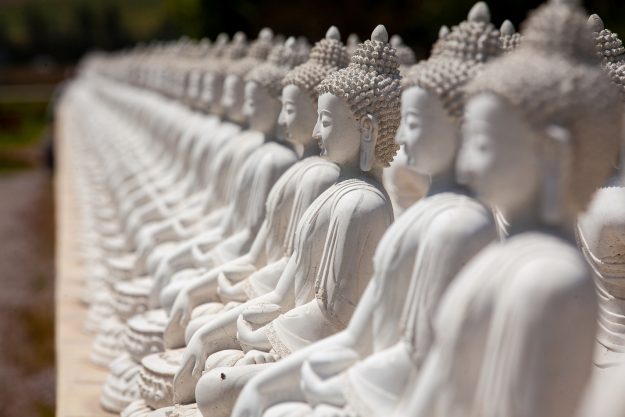
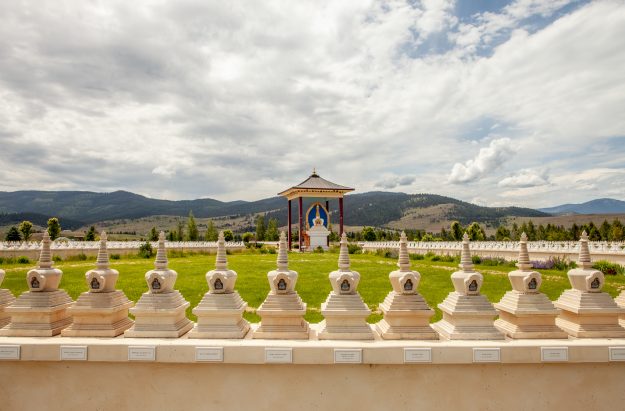
The last Buddha statue was installed around seven years ago thanks to the generosity of sponsors. Many are named on the monuments they helped create. Other plaques instead name people important to donors, like “Sacajawea and All Women of the World,” and in some cases, beloved pets, including a cat named Slug. Others simply signed the monument they dedicated with a blessing, including “Peace, Love and Light for All.”
Symbols of peace are endless inside and outside this mighty circle, including a still pond and 1,000 plants and trees growing as an example of “safeguarding and replenishing” the environment. Colorful prayer flags dance in the wind from a hill just above the grand dharma wheel. Smaller monuments along walking paths, such as rocks chiseled with Buddha wisdom, are no less significant. One rock reads: “Let yourself be open and life will be easier. A spoon of salt in a glass of water makes the water undrinkable. A spoon of salt in a lake is almost unnoticed.”
* * *
The three tribes of the Flathead Reservation—the Bitterroot Salish, Upper Pend d’Oreille, and the Kootenai—are really friendly people, McDonald says, and that openness means “all religious groups are always welcomed here.” A variety moved onto the reservation over the years, he says, including a colony of Amish, Mennonites, German Baptists, and Latter-day Saints—making the Buddhists’ arrival not at all uncommon to tribes who have seen endless waves of newcomers over the past few centuries.
The Flathead Reservation is beautiful country, so beautiful that Congress passed the Flathead Allotment Act in 1904, opening it up to homesteading for non-Native people, and once again breaking another treaty with tribes. Since then, McDonald says, “we’ve been a minority on our own reservation.”
Some purchase land with little thought of the tribes who still call it home. That wasn’t the case with Rinpoche, who invited spiritual leaders of the tribes to accompany him from the start, including during land rituals performed in both Tibetan Buddhist and Native American tradition. During one of those rituals, Small Salmon added his blessings from the front of a special procession at the garden.
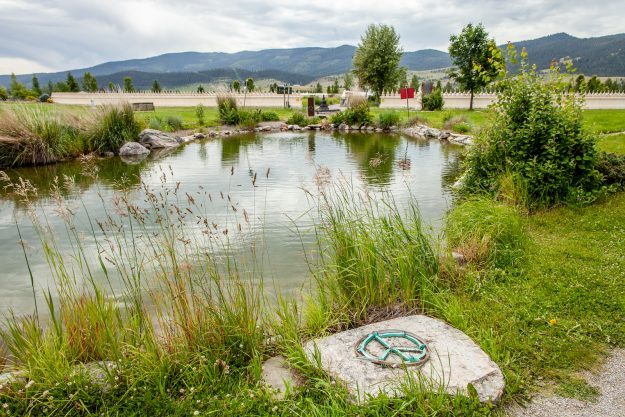
“It makes me feel good,” the 84-year-old Pend d’Oreille man says of walking with the Tibetans. “It makes me kind of honored, you know.”
So does their keeping in touch.
“Rinpoche is always asking about me … and that’s wonderful,” Small Salmon says, “to share our stories together.”
Stephen Lozar, a former tribal council member for the Confederated Salish and Kootenai Tribes, was thrilled about these Tibetan neighbors from the start.
“I actually was so excited I yelled out in the tribal council meeting,” Lozar recalled in 2011 for a PBS broadcast. “I think it’s a spectacular opportunity for cross-cultural associations that are peace-based, that are based in the holiness of this land.”
McDonald describes the Tibetans as “very low key,” interactive and respectful. “And that’s really what you ask for, right?” he says of having them as neighbors. “You want to be inclusive and be included and be respected. So it’s a two-way street, and I think that they’ve done pretty well.”
* * *
When Rinpoche is teaching at the Garden of One Thousand Buddhas, he resides in a modest home on the property. A collection of crystals and traditional Tibetan art adorn its interior, including colorful textiles and embroidered leather. Many treasures are wonderfully akin to Native American art, including the turquoise. Tibetans consider the precious stone to be “like a life force,” explains Rinpoche’s secretary, Khenpo Namchak Dorji, while serving as an interpreter for Rinpoche.
Sitting beside them, Tsering Karchungtsang, executive director of the garden, pulls at a necklace he’s wearing, featuring a small piece of turquoise, and says Tibetans always have this sacred stone with them. Karchungtsang sees his Tibetan grandparents in the features of his Native American neighbors, including their braided hair. And while attending their annual powwows, with round dancing and the use of feathers for ornamentation, like Tibetans, he’s filled with the feeling that “my people are dancing there.”
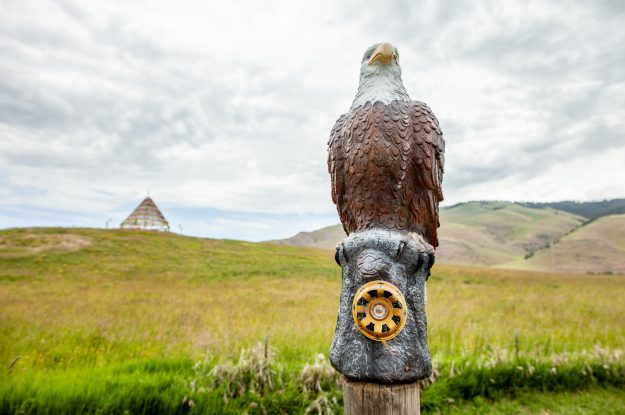
Rinpoche says when Small Salmon blessed the Garden of One Thousand Buddhas, his smoke ritual of burning sage, drumming, and invoking ancestors was like ceremonies performed by traditional Tibetans practicing Bon, or shamanism, before Buddhism came to Tibet. And like Native Americans, Tibetan Buddhists believe in sharing prayers and offerings before starting construction, Karchungtsang says. “We don’t dig in soil right away,” he adds—consideration is first given to whether the project is OK for the land and its native inhabitants.
All these things make Rinpoche think some scientists could be right about a theory that people might have first arrived in North America through a lost land bridge connecting Asia and Alaska, making Tibetans and Native Americans anciently connected.
The similarities go beyond cultural customs. There’s also a shared understanding of what persecution feels like. Tibetan culture has been repressed in Tibet since the country was invaded by China over seventy years ago, resulting in an estimated 1.2 million Tibetan deaths. The Dalai Lama was forced to flee and has lived in exile since 1959. In the Americas, millions of Indigenous people were killed in a genocide that spanned centuries.
“The tribes are very sympathetic to anybody that’s had oppression like the tribes have had against them. We’ve walked in their shoes,” McDonald says. “A lot of our membership feel it every day as far as racism, oppression, and conformity to dominant society—that type of pressure.”
For Small Salmon, the trauma began as a boy while attending a boarding school for Native Americans. Torn away from his family, he was abused at the school and not allowed to speak his Salish language. At age 84, he’s now teaching that language to children on the reservation at a school near the Garden of One Thousand Buddhas.
“Stephen is trying very hard to pass this language and culture on, and Rinpoche is leading his people in the same way,” Juanita Small Salmon says. “They’re working really hard at saving that culture and practicing it. Their lives are kind of parallel in a way when you look at it.”
* * *
Just north of the Garden of One Thousand Buddhas sits another kind of peace garden: the Bison Range, formerly known as the National Bison Range. The range is in its second year of being fully managed by the Confederated Salish and Kootenai Tribes.
The change restored the range to its original Indigenous stewardship. When the National Bison Range—an 18,766-acre square carved into the center of the Flathead Reservation— was established in 1908, it protected bison, or their descendants, that were brought to the reservation in the 1870s by a man named Little Falcon Robe. The Ql̓ispé (also known as Kalispel or Pend d’Oreille) man led some orphaned bison calves across the Continental Divide to the Flathead Reservation at a time when mass slaughter by white settlers put plains bison on the brink of extinction. Bison from that herd were also used to revive a dwindling population of the animals at Yellowstone National Park in the early 1900s.
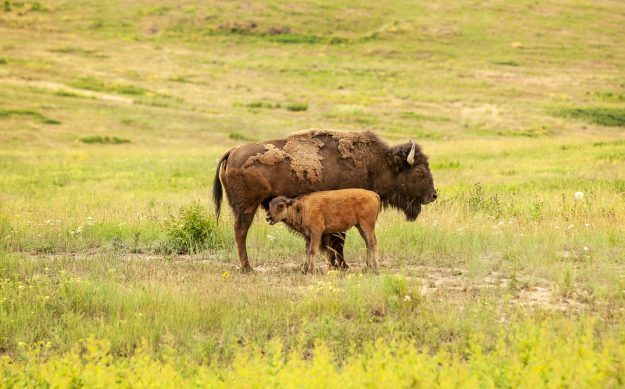
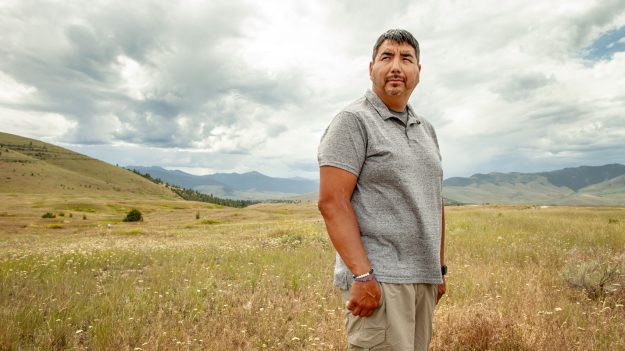
Martin Charlo, a Confederated Salish and Kootenai tribal council member, relates his tribe’s generosity with that of caretakers at the nearby Garden of One Thousand Buddhas.
“Back to being good neighbors, we’re trying to help establish other herds in eastern Montana. … We’re always willing to share knowledge and resources if possible,” Charlo says, while gazing out upon the Bison Range earlier this summer. “I feel like the garden down there does the same.”
Beneath each of the garden’s 1,000 Buddha statues are the words, “May All Beings Benefit!” That includes even the smallest of creatures, like insects, Karchungtsang explains. He’s happy that a family of foxes found sanctuary around the garden’s prayer flag mound. The foxes are a bane to some nearby farmers. Rinpoche says that Tibetans, like Native Americans, find sacred symbolism in animals, including eagles and hawks.
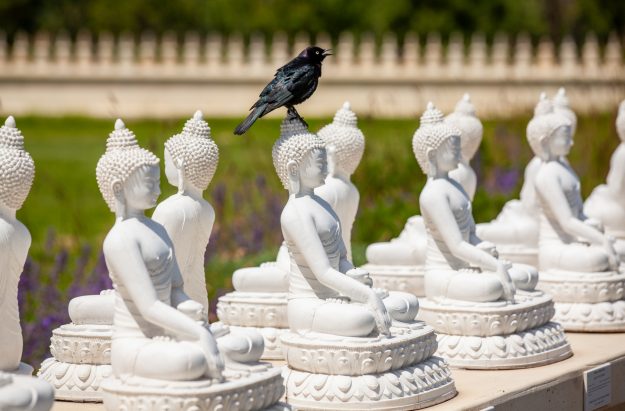
One of the most revered on the Bison Range was a rare white bison called Big Medicine, named after the gift that he was. After the creature’s death the same year the Dalai Lama was forced into exile, Big Medicine’s body was shipped to Helena, where it became a museum display. The Montana Historical Society agreed last fall—at the urging of tribal members—to send the white bison’s body home to the Flathead Reservation, which will likely happen once a new Bison Range visitor center is built.
Rick Eneas, executive officer for the Confederated Salish and Kootenai Tribes, said last year about Big Medicine that “a symbol like this allows us to feel proud of who we are and will help us understand who we can be in the future.”
The same can be said of the Garden of One Thousand Buddhas. Understanding our connection to the Earth and divine source is what both groups are striving for, Juanita Small Salmon says.
“These teachings are really important, whether it’s coming from the garden or coming from Native Americans,” she says. “We all need to learn.”
Thank you for subscribing to Tricycle! As a nonprofit, we depend on readers like you to keep Buddhist teachings and practices widely available.
